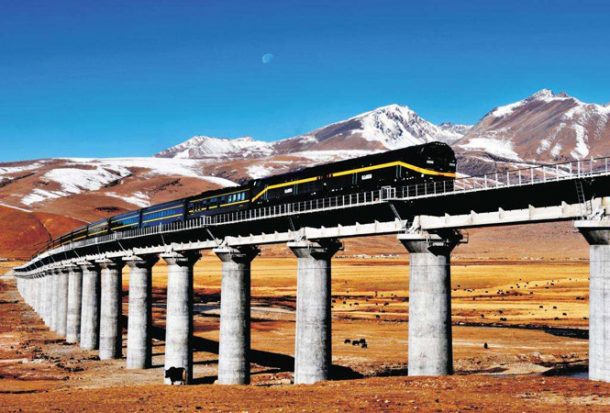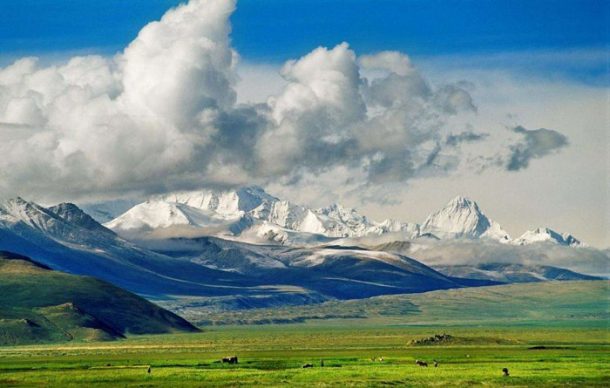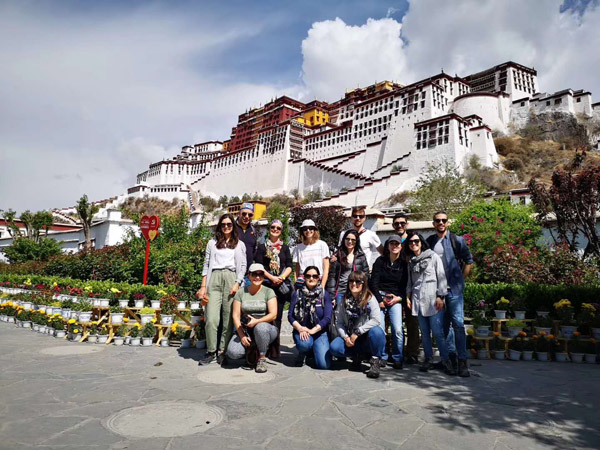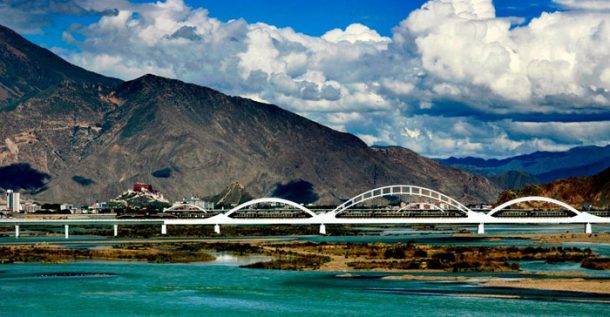Spectacular Scenery of the Qinghai Tibet Railway to Lhasa
The Qinghai Tibet Railway, which runs from Xining in Qinghai Province to Lhasa in the Tibet Autonomous Region (TAR), is the world’s highest railway and the main train route to Lhasa from mainland China. Stretching for 1,956 kilometers across the vast Qinghai Tibet Plateau, this unique railway is a massive feat of engineering and an amazing way to get to the Tibetan capital for a tour of the region.

The elevation along the railway line changes constantly and it is this constant change in altitude that provides travelers with some of the most outstanding landscapes and scenery of any train journey anywhere in the world. This amazing scenery along the route of the Qinghai Tibet railway is the major highlight of the entire trip by train to Lhasa, and even this can change from season to season. The scenery can be divided into three main sections, all of which are different and have their own individual qualities and highlights. The three main sections are from Xining to Golmud, from Golmud to Nagqu, and from Nagqu to Lhasa. It is one of the best ways to travel Tibet from mainland China.
Table of Contents
Xining to Golmud
The first part of the trip to Lhasa from Xining is the stretch that runs to Golmud, where the train starts its steep climb up to the higher altitudes of the Tibetan plateau and the high mountain ranges that fringe the northern boundaries of the Tibet Autonomous Region. While these views may not be as amazing as those from Golmud onwards, with their spectacular plateau landscapes, there are plenty of things to see from the windows of the trains between Xining and Golmud.
After departing from Xining, the first of the amazing sights you will be greeted with is the awesome Qinghai Lake, the largest lake in China. Just 150km outside Xining the lake comes into view as the train nears it, and passes alongside this vast body of salt water at an altitude of around 3,260 meters above sea level. The lake stretches for miles in both directions, and the stunning blue waters of this beautiful lake are backed by the distant snow-clad mountains that lie to the south of the Gobi desert.

Another of the most visually impacting sights along the route to Golmud is the Yardang Landform that lies just outside this small Qinghai town. Caused by wind erosion and wear from dust particles in the air, these small hills are sloping rock formations that are like waves in the landscape, strung out in lines and waves along the area close by Nanbaxian Village, just outside Golmud.
However, these are not the only beautiful sights along this stretch of the railway line. After the amazing sight of the Qinghai Lake, comes the astounding Qarhan Salt Lake, known locally as the “Sky Mirror” because of the way the lake perfectly and clearly reflects the blue cloud-dotted skies above. Stretching for more than 160km from east to west, this vast lake is the repository of almost all of the salt sold in China.
It is estimated that this single lake alone could provide enough salt for the entire population of the planet for around 1,000 years. Part of the railway line to Golmud from Xining actually sits on the lake itself, built on the salt deposits of the lake, so you get an awesome view of the lake and the salt it provides as you pass by.
Golmud to Nagqu
The section of the journey from Golmud to Lhasa is the most breathtaking in terms of landscapes and scenery, and is one of the most exciting stretches of the journey. The train takes its route from the Qaidam Basin in Qinghai to the snowy mountains that stretch along the plateau to the north of the TAR.
While it may be dark for most of this stretch of the route from Golmud to Nagqu, as the sun rises in the east, the train speeds over the famous Tanggula Pass and into the TAR for its journey to Nagqu. After departing from Golmud, the train starts its steep climb but into the Kunlun Mountains, which form part of the Transhimalaya that stretches across the north of the plateau region.

Crossing the Kunlun Mountains – where you may be able to make out Yuzhu Peak (4,160m), the highest peak in the range – the train drops down the other side to enter the famous Kekexili (Hoh Xil) National Nature Reserve, which stretches out between the Kunlun Mountains and the Tanggula Mountains. The least populated and most isolated region in the northwest of the plateau, this amazing area is home to dozens of species of protected wildlife, including the Tibetan antelopes, wild yaks, Tibetan wild donkeys, and much more.
Crossing the vast expanse of the reserve, the train stops at the Tuotuo He River Station, which gives you a chance to alight for a few minutes to get an amazing view of the expansive natural scenery of the plains and the beautiful, wide river that feeds this isolated landscape. Then it is on to the boundary between Qinghai and Tibet, the Tanggula Mountains. The train stops briefly at the Tanggula Railway Station, the world’s highest railway station at 5,072 meters above sea level. From here, the highest point of the railway line, you cross the pass and head down into Tibet.
After Tanggula, the train passes alongside the beautiful Tsonag Lake (4,650m), also known as Cona Lake in China, the lakeshore lying just 20 meters from the tracks. One of the highest freshwater lakes in China, the still water reflects the distant mountains perfectly, as the train steams on to the vast Changtang Prairie and down to Nagqu.
Nagqu to Lhasa
From Nagqu, the train starts its slow descent to Lhasa, as the railway line crosses the immense Changtang Prairie and the yak grazing pastures of the north of the region. From here, daylight is present and the amazing scenery of the plateau region is striking out of the windows of the train.
The vast Changtang Grasslands are a frigid region of Tibet that lies between the Tanggula Mountains and the Nyenchen Tanglha Mountains in northern Tibet. Lying at more than 4,400 meters above sea level, these vast grasslands are the home to thousands of nomadic herders and their families, as well as a huge number of yaks. An immense open prairie that stretches as far as the eye can see in all directions, this is one of the most impressive sights along the route of the railway.

As the train heads south, it passes alongside the famous Nyenchen Tanglha Mountains, a 1,000-kilometer sub-range of the Transhimalaya and the closest high mountains to the city of Lhasa. The highest peak of this huge range in the middle of the plateau is Mount Nyenchen Tanglha, also known as Nyainqêntanglha Feng, which sits at an altitude of 7,162 meters above sea level.
The train travels down alongside the mountain range, with Lake Namtso lying on the other side, just out of sight. As the train travels southwards, it passes by the famous Yangpachen Hot Springs, one of the few hot springs in Tibet that are popular with tourists. It is also the site of one of China’s largest geothermal fields for power production. The geothermal vents have been harnessed to provide an electrical supply to Lhasa.
Finally, as the train heads towards your final destination of Lhasa, the tracks cross the Lhasa River over the modern railway bridge. The river is one of the life-sources for many of the wildfowl that inhabit this area of the plateau, as well as the migratory birds that fly south in the winter from their northern Tibetan feeding grounds. Once across the river, the train finally pulls into the railway station in Lhasa, just a short distance from the city center, and the start of your main tour of Tibet.
Recent Posts
The Ultimate Guide to Tibet Tours, Travel, and Trekking Adventures
How to Explore Tibetan Culture
Exploring Lhasa:The Heart of Tibet
All Categories
- About Tibet
- book a Tibet tour
- Buddhism Practice
- Budget Tour
- China-Tibet Train
- Customized Tibet tour
- Historical Sites
- Hot Springs in Tibet
- News
- Photography in Tibet
- Tibet attraction
- Tibet Group Visa
- Tibet Motorcycle Tour
- Tibet Small Group Tours
- Tibet Tours and Tibetan Tour Guide
- Tibet Train
- Tibet Travel FAQs
- Tibet Travel Information
- Tibet Travel News
- Tibet Travel Permit Update
- Tibet Travel Prices Rises
- Tibet Trek
- Tibet Trekking Tour
- Tibet weather and climate
- Tibet Wildlife animals
- Tibet Winter Tour
- Tibetan Buddhism
- Tibetan Cultural Features
- Tibetan Culture and Poeple
- Tibetan Festivals
- What to see in Tibet



